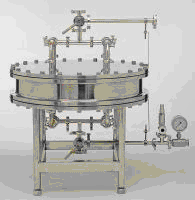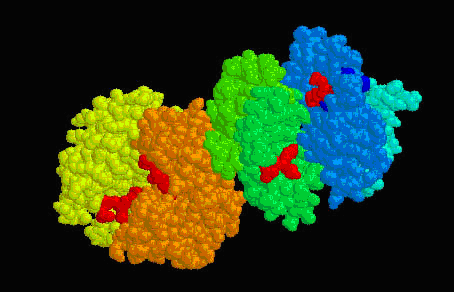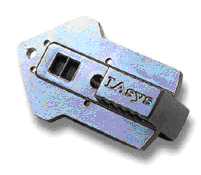PUBLICATIONS - ΔΗΜΟΣΙΕΥΣΕΙΣ
1. Affinity Methods in Bioseparation. Y.D. CLONIS Proceedings of the 6th European Congress on Biotechnology, Florence, Italy, June v.13-17 (1993) pp. 527-533.
2. Simultaneous Separation and Purification of Pyruvate Kinase and Lactate Dehydrogenase by Dye-ligand Chromatography. T. MAKRIYANNIS and Y.D. CLONIS. Process Biochem., 28 (1993) 179-185.
3. The Affinity Technology in Downstream Processing. N.E. LABROU and Y.D. CLONIS J. Biotechnol., 36 (1994) 95-119.
N.E. LABROU and Y.D. CLONIS Arch. Biochem. Biophys., 316 (1995) 169-178.
N.E. LABROU and Y.D. CLONIS J. Biotechnol., 40 (1995) 59-70.
6. Oxaloacetate Decarboxylase: on the Mode of Interaction with Substrate-Mimetic Affinity Ligands. N.E. LABROU and Y.D. CLONIS Arch. Biochem. Biophys., 321 (1995) 61-70.
7. Biomimetic-dye Affinity Chromatography for the Purification of Bovine Heart Lactate Dehydrogenase N.E. LABROU and Y.D. CLONIS J. Chromatogr. A, 718 (1995) 35-44.
N.E. LABROU, A. KARAGOUNI and Y.D. CLONIS Biotechnol. Bioengin., 48 (1995) 278-288.
N.E. LABROU and Y.D. CLONIS J. Biotechnol., 45 (1996) 185-194.
N.E. LABROU, E. ELIOPOULOS and Y.D. CLONIS Biochem. J., 315 (1996) 695-703.
11. Peptide Affinity Ligands in Protein Purification Technology. Y.D. CLONIS Hellenic Forum on Bioactive Peptides, Crete University Press, 1997, pp. 121-128.
V. KOTSIRA and Y.D. CLONIS Arch. Biochem. Biophys., 340 (1997) 239-249.
13. Simultaneous Purification of L-Malate Dehydrogenase and L-Lactate Dehydrogenase from Bovine Heart by Biomimetic-dye Affinity Chromatography. N.E. LABROU and Y.D. CLONIS. Bioprocess Engin., 16 (1997) 157-161.
14. L-Malate Dehydrogenase from Pseudomonas studzeri: Purification and Characterization. N.E. LABROU and Y.D. CLONIS Arch. Biochem. Biophys., 337 (1997) 103-114.
T. MAKRIYANNIS and Y.D. CLONIS Biotechnol. Bioengin., 53 (1997) 49-57.
V.E. MAZI, N. COSMIDIS, Y.D. CLONIS and M. LOUKAS Biotechnol. Progr., 14 (1998) 294-299.
17. Oxaloacetate Decarboxylase from Pseudomonas studzeri: Purification and Characterization. N.E. LABROU and Y.D. CLONIS Arch. Biochem. Biophys., 365 (1999) 17-24.
N.E. LABROU, E. ELIOPOULOS and Y.D. CLONIS Biotechnol. Bioengin., 63 (1999) 322-332.
19. Affinity Separation: Dye-Ligands. Y.D. CLONIS Encyclopaedia of Separation Science (I. Wilson, ed.), Academic Press Ltd., London, 2000, pp. 259-265.
20. Biomimetic Dyes as Affinity Chromatography Tools in Enzyme Purification. Y.D. CLONIS, N.E. LABROU, V.Ph. KOTSIRA, C. MAZITSOS, S. MELISSIS and G. GOGOLAS J. Chromatogr. A, 891 (2000) 33-44.
21. Improved Purification of Candida boidinii Formate Dehydrogenase. N.E. LABROU Bioseparation, 9 (2000) 99-104
22. Dye-ligand affinity chromatography for protein separation and purification. N.E. LABROU Methods in Molecular Biology: ‘Affinity Chromatography: Methods and Protocols’. (J.M. Walker, ed.), Humana Press, USA, 2000, v.147, pp. 129-139.
S. MELISSIS, D.J. RIGDEN and Y.D. CLONIS J. Chromatogr. A, 917 (2001) 29-43.
24. Dye-ligand affinity adsorbents for enzyme purification. N.E. LABROU Appl. Biochem. Biotechnol., Part B : Mol. Biotechnol., 20 (2002) 77-84
25. Immobilised synthetic dyes in affinity chromatography. N.E. LABROU and Y.D. CLONIS Biochromatography - Theory and Practice (M.A. Vijayalakshmi, ed.), Taylor and Francis Publishers, London, 2002, Chap. 8, pp. 235-251.
26. Galactosyl-biomimetic dye-ligands for the purification of Dactylium dendroides galactose oxidase. C.F. MAZITSOS, D.J. RIGDEN, P.G. TSOUNGAS and Y.D. CLONIS. J. Chromatogr. A, 954 (2002) 137-150.
27. Affinity chromatography. N.E. LABROU Methods for Affinity-Based Separations Of Enzymes and Proteins, (M.N., Gupta, ed.), Birkhϊuser Verlag AG, Switzerland, 2002, 16-28.
28. Dye-ligand
affinity adsorbents for enzyme purification.
Mol. Biotechnol., 20 (2002) 77-84.
29. Dye-ligand and biomimetic affinity chromatography. N.E. Labrou, K. Mazitsos and Y. Clonis In: D.S. Hage (Ed.), Handbook of Affinity Chromatography. Marcel Dekker, Inc, New York, (in press).
30.
Galactosyl-mimodye ligands for Pseudomonas fluorescens β-galactose
dehydrogenase: design, synthesis and evaluation.
31.
Design and selection of ligands for affinity chromatography.
J. Chromatogr. B, 790 (2003) 67-78. 32.
Designed chimaeric galactosyl-mimodye ligands for the
purification of Pseudomonas fluorescens β-galactose
dehydrogenase. 33.
Interaction of L-glutamate oxidase with triazine dyes:
selection of ligands for affinity chromatography. 34. Affinity chromatography matures as bioinformatic and combinatorial tools develop. Y.D. CLONIS J. Chromatogr. A, 1101 (2006) 1-24.
35. Lock-and-key motif as a concept for designing affinity adsorbents for protein purification. D. PLATIS, C.A. SOTRIFFER, Y.D. CLONIS, AND N.E. LABROU J. Chromatogr. A, 1128 (2006) 138-151
36.
Nucleotide-mimetic synthetic ligands for DNA-recognizing enzymes. One-step
purification of Pfu DNA polymerase.
J. Chromatogr. A , 1122 (2006) pp. 63-75
J. Chromatogr. A, 1128 (2006) 114-124.
T. DALAKOURAS, B.J. SMITH, D. PLATIS, M.M.J. COX, N.E. LABROU J. Chromatogr. A, 1136 (2006) 48-56
39. One-step purification of Taq DNA polymerase using nucleotide-mimetic affinity chromatography. S. Melissis, N.E. Labrou, Y.D. Clonis Biotechnol. J., 2 (2007) 121-132.
J. Separation Sci., 31 (2008) 636-645.
41. Cost-effective production of a vaginal protein microbicide to prevent HIV transmission. K. Ramessar, T. Rademacher, M. Sack, J. Stadlmann, D. Platis, G. Stiegler, N.E. Labrou, F. Altmann, J. Ma, E. Stöger, T. Capell, P. Christou Proc Natl Acad Sci U S A. 105 (2008) 3727-32
D. Platis, J. Drossard, R. Fischer, J.K. Ma, N.E. Labrou J Chromatogr A, 1211 (2008) 80-89.
D. Platis, N.E. Labrou Biotechnol J., 4 (2009) 1320-1327.
D. Platis, A. Maltezos, J.K. Ma, N.E. Labrou J. Mol. Recognit., in press
45. Purification of Moloney Murine Leukemia virus reverse transcriptase lacking RNAse activity (M-MLVH -RT) on a 9-aminoethyladenine-[1,6-diamine-hexane]-triazine, selected from a combinatorial library of dNTP-mimetic ligands. S. Melissis, A. Papageorgiou, N.E. Labrou, Y.D. Clonis J. Chromatogr. Sci., in press.
N.E. LABROU, E. ELIOPOULOS and Y.D. CLONIS Biochem. J., 315 (1996) 687-693.
V. KOTSIRA and Y.D. CLONIS Arch. Biochem. Biophys., 356 (1998) 117-126.
3. Biochemical Differences Between Products of the ADH Locus in Olive Fruit Fly (Bactrocera oleae). V.E. MAZI, N. COSMIDIS, Μ. LOUKAS, Y.D. CLONIS and E. ZOUROS. Biochem. Genet., 36 (1998) 259-269.
G. AGGELIS, S. FAKAS, S. MELISSIS and Y.D. CLONIS J. Biotechnol., 72 (1999) 127-139.
5. Afinity Labeling of Oxaloacetate Decarboxylase by Novel Dichlorotriazine Linked α-Ketoacids. N.E. LABROU Protein J., 18 (1999) 729-733.
6. Dye Affinity Labelling of Yeast Alcohol Dehydrogenase. N.E. LABROU J. Enz. Inhibition, 15 (2000) 487-496.
N.E. LABROU, D.J. RIGDEN and Y.D. CLONIS Eur. J. Biochem., 267 (2000) 6657-6664.
8. Active Site Characterization of Candida boidinii Formate Dehydrogenase. N.E. LABROU and D.J. RIGDEN Biochem. J., 354 (2001) 455-463.
9. Functional
and
structural and role of the glutathione
binding residues in maize glutathione S-transferase.
10.
The conserved Asn49 in maize glutathione S-transferase
modulates substrate binding, catalysis and intrasubunit communication.
11.Glutathione S-transferase: de novo design of glutathionyl-analogues and combinatorial design of novel enzyme reactions. N.E. Labrou, Axarli, I., Melissis, S., Kotzia, G., Katsos, N. & Y.D. Clonis. 3rd Forum on Bioactive Peptides. Ed.: P. Kordopatis, Typorama, Patra, 2003, 249-258.
12. The structure-function relationship in the clostripain family of peptidases. Eur.J. Biochem., 271 (2004) 983-992.
13.
Engineering the pH-dependence of kinetic parameters of maize
glutathione S-transferase I by site-directed mutagenesis.
14.
S-(2,3-dichlorotriazinyl)glutathione: A new affinity label for probing the
structure and function of glutathione transferases. Eur. J. Biochem., 271 (2004) 3503-3511
15. Characterization of the ligandin site of maize glutathione S-transferase I. I.A. Axarli, D.J. Rigden, N.E. Labrou Biochem. J., 382 (2004) 885-893
16.
Engineering the xenobiotic substrate specificity of maize glutathione S-transferase
I. Protein Engine. Des. Select., 17 (2004) 741-748
17.
Directed enzyme evolution: bridging the gap
between natural enzymes and commercial applications. Biomol. Engine., 22 (2005), pp. vii-ix
I. AXARLI, A. PRIGIPAKI, N.E. LABROU Biomol. Engin., 22 (2005) 81-88.
N.E. Labrou, M. Karavangeli, A. Tsaftaris, A., Y.D. Clonis, Planta, 222 (2005) 91-97.
M. Karavangeli, N.E. Labrou, Y.D. Clonis, A. Tsaftaris Biomol. Engine., 22 (2005) 121-128.
21. Cloning, expression and characterisation of Erwinia carotovora L-asparaginase. G.A. Kotzia, N.E. Labrou J. Biotechnol., 119 (2005) 309-323.
B.J. Smith, T. Huyton, R.P. Joosten, J.L. McKimm-Breschkin, J.-G. Zhang, C.S. Luo, M.-Z. Lou, (...), T.P.J. Garrett Acta Crystallogr. (Section D: Biol. Crystallogr.), 62 (2006) 947-952.
D. Platis, B.J. Smith, T. Huyton, N.E. Labrou Biochem. J., 399 (2006) 215-223.
24. L-Asparaginase from Erwinia Chrysanthemi 3937: Cloning, expression and characterization. J. Biotechnol., 127 (2007) 657-669.
G.A. Kotzia, K. Lappa, N.E. Labrou Biochem. J., 404 (2007) 337-343.
26. A dehydrochlorinase-based pH change assay for determination of DDT is sprayed surfaces. E. Morou, H.M. Ismail, A.J. Dowd, J. Hemingway, N.E. Labrou, M. Paine, J. Vontas Anal Biochem., 378 (2008) 60-64
27.
Structure-guided alteration of coenzyme specificity of formate dehydrogenase by
saturation mutagenesis to enable efficient utilization of NADP+
FEBS Journal,
275 (2008) 3859-3869. D. Platis, D., N.E. Labrou Curr. Med. Chem., 15 (2008) 1940-1955.
I. Axarli, P. Dhavala, A. Papageorgiou, N.E. Labrou J. Mol. Biol., 385 (2009) 984-1002.
30. Engineering thermal stability of l-asparaginase by in vitro directed evolution. G.A. Kotzia, N.E. Labrou FEBS Journal, 276 (2009) 1750-1761.
I. Axarli, N.E. Labrou, C. Petrou, N. Rassias, P. Cordopatis, Y.D. Clonis Eur. J. Med. Chem., 44 (2009) 2009-2016.
A. Andreadeli, E. Flemetakis, I. Axarli, M. Dimou, M.K. Udvardi, P. Katinakis, N.E. Labrou Biochim. Biophys. Acta, 1794 (2009) 976-984.
33. Molecular and biochemical characterization of the parvulin-type PPIases in Lotus japonicus. E.D. Kouri, N.E. Labrou, S.D. Garbis, K.I. Kalliampakou, C. Stedel, M. Dimou, M.K. Udvardi, P. KATINAKIS, E. Flemetakis Plant Physiol., 150 (2009) 1160-1173.
I. Axarli, P. Dhavala, A.C. Papageorgiou, N.E. Labrou Biochem J., 422 (2009) 247-256.
35. Glutathione transferases: emerging multidisciplinary tools in red and green biotechnology. E.G. Chronopoulou, N.E. LABROU Recent Pat Biotechnol., in press.
1. Colorimetric assay for Lecithin using two co-immobilized enzymes and an indicator dye conjugate. V. KOTSIRA and Y.D. CLONIS
J. Agric. Food Chem., 46 (1998)
3389-3394. V.G. ANDREOU and Y.D. CLONIS
3. Φορητός ενζυμικός βιοαιθητήρας οπτικών ινών που βασίζεται σε τεχνολογία
Sol-Gel για τον προσδιορισμό οργανοφωσφορικών και καρβαμιδικών φυτοφαρμάκων σε
φυσικά ύδατα. V.G. ANDREOU and Y.D. CLONIS Analyt. Chim. Acta, 460 (2002) 151-161.
5. Engineering sensitive glutathione transferase for the detection of xenobiotics. P. Kapoli, I.A. Axarli, D. Platis, M. Fragoulaki, M. Paine, J. Hemingway, J. Vontas, N.E. Labrou Biosens. Bioelectron., 24 (2008) 498-503.
1. Ενζυμική Βιοτεχνολογία Ι.Δ. ΚΛΩΝΗΣ (συγγραφέας) Πανεπιστημιακές Εκδόσεις Κρήτης, ΙΤΕ, Ηράκλειο, Κρήτη, 1997.
2. Ενζυμολογία Ι.Δ. ΚΛΩΝΗΣ (συγγραφέας) Εκδόσεις ΕΜΒΡΥΟ, Αιγάλεω, Αττική, 2007.
|





